display CADILLAC ESCALADE ESV 2009 Owners Manual
[x] Cancel search | Manufacturer: CADILLAC, Model Year: 2009, Model line: ESCALADE ESV, Model: CADILLAC ESCALADE ESV 2009Pages: 602, PDF Size: 5.18 MB
Page 11 of 602
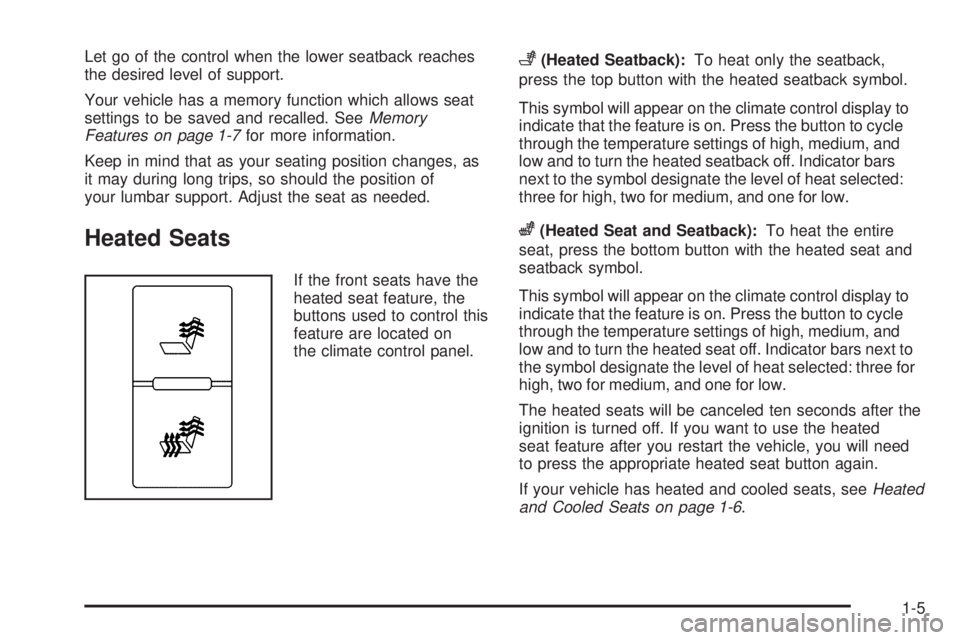
Let go of the control when the lower seatback reaches
the desired level of support.
Your vehicle has a memory function which allows seat
settings to be saved and recalled. See Memory
Features on page 1-7 for more information.
Keep in mind that as your seating position changes, as
it may during long trips, so should the position of
your lumbar support. Adjust the seat as needed.
Heated Seats If the front seats have the
heated seat feature, the
buttons used to control this
feature are located on
the climate control panel. + (Heated Seatback): To heat only the seatback,
press the top button with the heated seatback symbol.
This symbol will appear on the climate control display to
indicate that the feature is on. Press the button to cycle
through the temperature settings of high, medium, and
low and to turn the heated seatback off. Indicator bars
next to the symbol designate the level of heat selected:
three for high, two for medium, and one for low.
z (Heated Seat and Seatback): To heat the entire
seat, press the bottom button with the heated seat and
seatback symbol.
This symbol will appear on the climate control display to
indicate that the feature is on. Press the button to cycle
through the temperature settings of high, medium, and
low and to turn the heated seat off. Indicator bars next to
the symbol designate the level of heat selected: three for
high, two for medium, and one for low.
The heated seats will be canceled ten seconds after the
ignition is turned off. If you want to use the heated
seat feature after you restart the vehicle, you will need
to press the appropriate heated seat button again.
If your vehicle has heated and cooled seats, see Heated
and Cooled Seats on page 1-6 .
1-5
Page 12 of 602
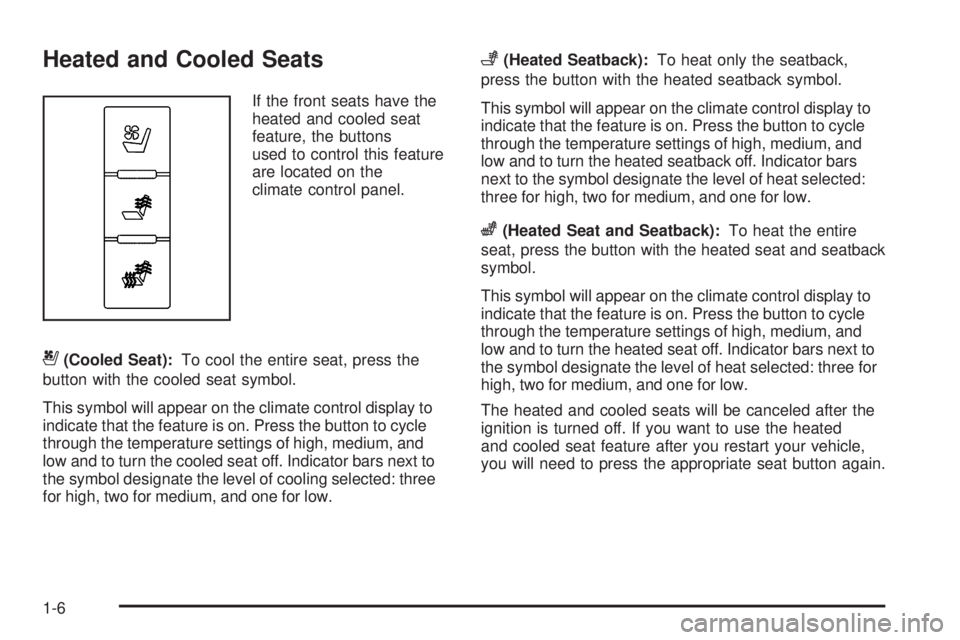
Heated and Cooled Seats If the front seats have the
heated and cooled seat
feature, the buttons
used to control this feature
are located on the
climate control panel.
{ (Cooled Seat): To cool the entire seat, press the
button with the cooled seat symbol.
This symbol will appear on the climate control display to
indicate that the feature is on. Press the button to cycle
through the temperature settings of high, medium, and
low and to turn the cooled seat off. Indicator bars next to
the symbol designate the level of cooling selected: three
for high, two for medium, and one for low. + (Heated Seatback): To heat only the seatback,
press the button with the heated seatback symbol.
This symbol will appear on the climate control display to
indicate that the feature is on. Press the button to cycle
through the temperature settings of high, medium, and
low and to turn the heated seatback off. Indicator bars
next to the symbol designate the level of heat selected:
three for high, two for medium, and one for low.
z (Heated Seat and Seatback): To heat the entire
seat, press the button with the heated seat and seatback
symbol.
This symbol will appear on the climate control display to
indicate that the feature is on. Press the button to cycle
through the temperature settings of high, medium, and
low and to turn the heated seat off. Indicator bars next to
the symbol designate the level of heat selected: three for
high, two for medium, and one for low.
The heated and cooled seats will be canceled after the
ignition is turned off. If you want to use the heated
and cooled seat feature after you restart your vehicle,
you will need to press the appropriate seat button again.
1-6
Page 16 of 602
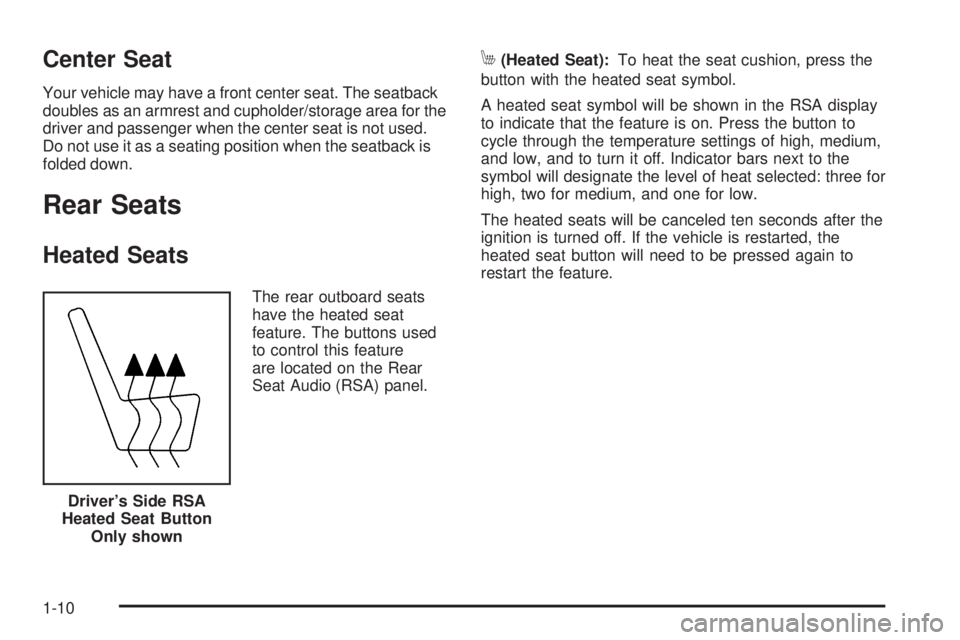
Center Seat Your vehicle may have a front center seat. The seatback
doubles as an armrest and cupholder/storage area for the
driver and passenger when the center seat is not used.
Do not use it as a seating position when the seatback is
folded down.
Rear Seats Heated Seats The rear outboard seats
have the heated seat
feature. The buttons used
to control this feature
are located on the Rear
Seat Audio (RSA) panel. M (Heated Seat): To heat the seat cushion, press the
button with the heated seat symbol.
A heated seat symbol will be shown in the RSA display
to indicate that the feature is on. Press the button to
cycle through the temperature settings of high, medium,
and low, and to turn it off. Indicator bars next to the
symbol will designate the level of heat selected: three for
high, two for medium, and one for low.
The heated seats will be canceled ten seconds after the
ignition is turned off. If the vehicle is restarted, the
heated seat button will need to be pressed again to
restart the feature.
Driver’s Side RSA
Heated Seat Button
Only shown
1-10
Page 108 of 602
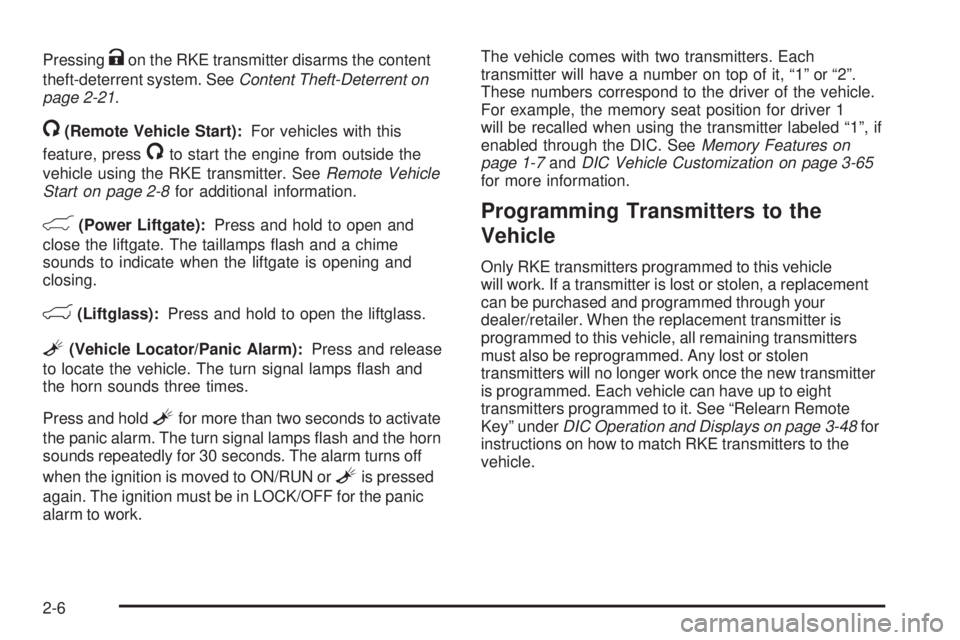
Pressing
K on the RKE transmitter disarms the content
theft-deterrent system. See Content Theft-Deterrent on
page 2-21 .
/ (Remote Vehicle Start): For vehicles with this
feature, press
/ to start the engine from outside the
vehicle using the RKE transmitter. See Remote Vehicle
Start on page 2-8 for additional information.
& (Power Liftgate): Press and hold to open and
close the liftgate. The taillamps �ash and a chime
sounds to indicate when the liftgate is opening and
closing.
m (Liftglass): Press and hold to open the liftglass.
L (Vehicle Locator/Panic Alarm): Press and release
to locate the vehicle. The turn signal lamps �ash and
the horn sounds three times.
Press and hold
L for more than two seconds to activate
the panic alarm. The turn signal lamps �ash and the horn
sounds repeatedly for 30 seconds. The alarm turns off
when the ignition is moved to ON/RUN or
L is pressed
again. The ignition must be in LOCK/OFF for the panic
alarm to work. The vehicle comes with two transmitters. Each
transmitter will have a number on top of it, “1” or “2”.
These numbers correspond to the driver of the vehicle.
For example, the memory seat position for driver 1
will be recalled when using the transmitter labeled “1”, if
enabled through the DIC. See Memory Features on
page 1-7 and DIC Vehicle Customization on page 3-65
for more information.
Programming Transmitters to the
Vehicle Only RKE transmitters programmed to this vehicle
will work. If a transmitter is lost or stolen, a replacement
can be purchased and programmed through your
dealer/retailer. When the replacement transmitter is
programmed to this vehicle, all remaining transmitters
must also be reprogrammed. Any lost or stolen
transmitters will no longer work once the new transmitter
is programmed. Each vehicle can have up to eight
transmitters programmed to it. See “Relearn Remote
Key” under DIC Operation and Displays on page 3-48 for
instructions on how to match RKE transmitters to the
vehicle.
2-6
Page 109 of 602
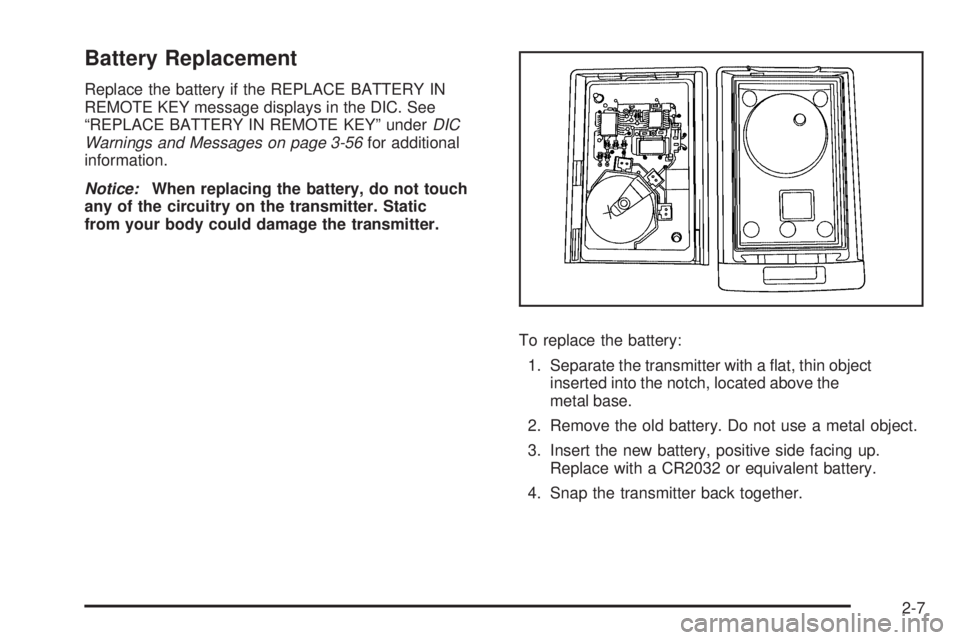
Battery Replacement Replace the battery if the REPLACE BATTERY IN
REMOTE KEY message displays in the DIC. See
“REPLACE BATTERY IN REMOTE KEY” under DIC
Warnings and Messages on page 3-56 for additional
information.
Notice: When replacing the battery, do not touch
any of the circuitry on the transmitter. Static
from your body could damage the transmitter.
To replace the battery:
1. Separate the transmitter with a �at, thin object
inserted into the notch, located above the
metal base.
2. Remove the old battery. Do not use a metal object.
3. Insert the new battery, positive side facing up.
Replace with a CR2032 or equivalent battery.
4. Snap the transmitter back together.
2-7
Page 127 of 602

Ignition Positions The ignition switch has
four different positions.
To shift out of P (Park), the ignition must be in ON/RUN
or ACC/ACCESSORY and the regular brake pedal must
be applied.
A (LOCK/OFF): This position locks the ignition. It may
also lock the steering wheel and automatic transmission.
The key can be removed in LOCK/OFF.
On vehicles with an automatic transmission, the shift
lever must be in P (Park) to turn the ignition switch to
LOCK/OFF.
The steering may bind with the wheels turned off center.
If this happens, move the steering wheel from right
to left while turning the key to ACC/ACCESSORY.
If this doesn’t work, then the vehicle needs service. Notice: Using a tool to force the key to turn in the
ignition could cause damage to the switch or break
the key. Use the correct key, make sure it is all the
way in, and turn it only with your hand. If the key
cannot be turned by hand, see your dealer/retailer.
B (ACC/ACCESSORY): This position lets things like the
radio and the windshield wipers operate while the
engine is off. Use this position if the vehicle must be
pushed or towed.
C (ON/RUN): This position can be used to operate the
electrical accessories and to display some instrument
panel cluster warning and indicator lights. The switch
stays in this position when the engine is running.
The transmission is also unlocked in this position
on automatic transmission vehicles.
If you leave the key in the ACC/ACCESSORY or ON/
RUN position with the engine off, the battery could be
drained. You may not be able to start the vehicle if the
battery is allowed to drain for an extended period of time.
D (START): This is the position that starts the engine.
When the engine starts, release the key. The ignition
switch returns to ON/RUN for driving.
A warning tone will sound when the driver door is
opened, the ignition is in ACC/ACCESSORY or
LOCK/OFF and the key is in the ignition.
2-25
Page 131 of 602

Automatic Transmission Operation If the vehicle is a Two-mode Hybrid, see the Two-mode
Hybrid manual for more information.
The vehicle has a Hydra-Matic ®
6L80 automatic
transmission, and has an electronic shift position
indicator within the instrument panel cluster.
The electronic shift position indicator displays
when the shift lever is moved out of P (Park).
There are several different positions for the shift lever.
P (Park): This position locks the rear wheels. It is the
best position to use when you start the engine because
the vehicle cannot move easily. When parked on a hill, especially when the vehicle has
a heavy load, you may notice an increase in the effort to
shift out of P (Park). See Torque Lock (Automatic
Transmission) under Shifting Into Park on page 2-36 for
more information.
{ CAUTION: It is dangerous to get out of the vehicle if the shift
lever is not fully in P (Park) with the parking brake
�rmly set. The vehicle can roll.
Do not leave the vehicle when the engine is
running unless you have to. If you have left the
engine running, the vehicle can move suddenly.
You or others could be injured. To be sure the
vehicle will not move, even when you are on fairly
level ground, always set the parking brake and
move the shift lever to P (Park). See Shifting Into
Park on page 2-36 . If you are pulling a trailer, see
Towing a Trailer on page 5-44 .
2-29
Page 134 of 602

Driver Shift Control (DSC)
The vehicle has Driver Shift Control (DSC). DSC
controls the vehicle’s transmission and vehicle speed
while driving down hill or towing a trailer by allowing you
to select a desired range of gears. To use this feature, do the following:
1. Move the shift lever to the M (Manual Mode).
2. Press the plus/minus button, to upshift or downshift
selecting the desired range of gears for current
driving conditions.
The DIC display will show the message MANUAL SHIFT
on the �rst line and the current gear will be displayed on
the second line. See Driver Information Center (DIC) on
page 3-47 and DIC Operation and Displays on page 3-48
for more information. The number displayed in the DIC is
the highest gear that can be used. However, the vehicle
can automatically shift to lower gears as it adjusts to
driving conditions. This means that all gears below
that number are available. When 5 (Fifth ) is selected,
1 (First) through 5 (Fifth) gears are automatically shifted
by the vehicle, but 6 (Sixth) cannot be used until the
plus/minus button located on the steering column lever
is used to change to the gear.
Grade Braking is not available when the Driver Shift
Control is active. See Tow/Haul Mode on page 2-33 for
more information.
While using the DSC, cruise control and the tow/haul
mode can be used.
2-32
Page 145 of 602

The display is located near
the passenger side rear
window and can be seen
by looking over your right
shoulder.
URPA uses three color-coded lights to provide distance
and system information.
How the System Works URPA comes on automatically when the shift lever is
moved into R (Reverse). The rear display brie�y
illuminates to indicate the system is working.
URPA operates only at speeds less than 5 mph (8 km/h).
If the vehicle is above this speed, the red light on the rear
display will �ash.
To be detected, objects must be at least 10 inches
(25.4 cm) off the ground and below liftgate level. Objects
must also be within 8 feet (2.5 m) from the rear bumper.
This distance may be less during warmer or humid
weather. A single beep will sound the �rst time an object is
detected between 40 inches (1 m) and 8 feet (2.5 m)
away. Beeping will occur continuously when the vehicle
is at 23 inches (0.6 m) or closer to an object.
The following describes what will occur with the URPA
display as the vehicle gets closer to a detected object:
Description English Metric
amber light 8 ft 2.5 m
amber/amber lights 40 in 1.0 m
amber/amber/red lights
and continuous beeping
for �ve seconds 23 in 0.6 m
amber/amber/red lights
�ashing and continuous
beeping for �ve seconds 1 ft 0.3 m
The system can be
disabled by pressing the
rear park aid disable button
located next to the radio.
The indicator light will come on and PARK ASSIST OFF
displays on the Driver Information Center (DIC) to
indicate that URPA is off, see DIC Warnings and
Messages on page 3-56 for information about clearing
the message.
2-43
Page 146 of 602

When the System Does Not Seem to
Work Properly If the URPA system will not activate due to a temporary
condition, the message PARK ASSIST OFF will be
displayed on the DIC and a red light will be shown on
the rear URPA display when the shift lever is moved into
R (Reverse). This occurs under the following conditions:
The driver disables the system.
The ultrasonic sensors are not clean. Keep the
vehicle’s rear bumper free of mud, dirt, snow,
ice and slush. For cleaning instructions, see
Washing Your Vehicle on page 6-100 .
A trailer was attached to the vehicle, or a bicycle or
an object was hanging out of the liftgate during the
last drive cycle, the red light may illuminate in the
rear display. Once the attached object is removed,
URPA will return to normal operation.
A tow bar is attached to the vehicle.
The vehicle’s bumper is damaged. Take the vehicle
to your dealer/retailer to repair the system.
Other conditions may affect system performance,
such as vibrations from a jackhammer or the
compression of air brakes on a very large truck.
If the system is still disabled, after driving forward at least
15 mph (25 km/h), take the vehicle to your dealer/retailer. Side Blind Zone Alert (SBZA) The vehicle may have a Side Blind Zone Alert (SBZA)
system. Read this entire section before using the system.
The SBZA system operates on a radio frequency
subject to Federal Communications Commission (FCC)
Rules and with Industry Canada.
This device complies with Part 15 of the FCC Rules.
Operation is subject to the following two conditions:
1. This device may not cause harmful interference.
2. This device must accept any interference received,
including interference that may cause undesired
operation.
This device complies with RSS-310 of Industry Canada.
Operation is subject to the following two conditions:
1. This device may not cause harmful interference.
2. This device must accept any interference received,
including interference that may cause undesired
operation.
Frequency of operation: 24.05GHz – 24.25GHz
Field Strength: Not greater than 2.5V/m peak (0.25V/m
average) at a distance of 3m
2-44